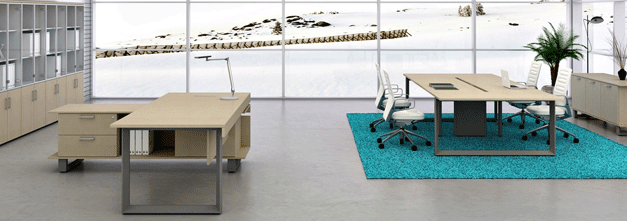The Psychology of Office Design: Using Furniture to Enhance Employee Well-being
Employee well-being is paramount to a thriving and productive workplace. As businesses evolve, so do
the approaches to office design. One often overlooked yet powerful aspect of creating a conducive work
environment is the strategic use of office furniture.
In this blog, we will explore the psychology behind office design and how the right furniture choices can
positively impact employee well-being, engagement, and overall productivity.

Psychology of Office Design
The psychology of office design refers to the study and application of psychological principles and
concepts in creating work environments that promote employee well-being, productivity, and overall
satisfaction. It involves understanding how various elements of office space, such as layout, lighting,
colours, furniture, and decor, can impact the psychological and emotional state of employees.
The goal of incorporating psychology into office design is to create a workspace that aligns with human
needs, preferences, and behaviours, ultimately leading to increased job satisfaction, motivation, and
performance. By considering the psychological aspects of design, companies can create a positive and
the supportive work environment that fosters creativity, collaboration, and a sense of belonging among
employees.
Some key principles of the psychology of office design include:
● Understanding and applying ergonomic principles to ensure that office furniture and equipment
are designed to support employee comfort and reduce the risk of physical strain or injuries.
● Recognising the impact of different colours on mood and emotions, and using appropriate colour
schemes to create a desired atmosphere in the workplace.
● Designing office layouts that promote interaction, communication, and collaboration among
employees, while also providing private spaces for focused work when needed.
● Incorporating natural elements like plants, natural lighting, and views of nature, which have been
shown to reduce stress and improve overall well-being.
● Understanding how noise levels and acoustics can affect concentration and productivity, and
implementing solutions to control sound in the office.
● Allowing employees to personalise their workspaces to create a sense of ownership and comfort,
which can enhance job satisfaction.
● Emphasising the connection between humans and nature by integrating natural elements into
the office environment, leading to increased creativity and reduced stress.
● Reflecting the company's values and culture through the design, can reinforce a sense of
pride and loyalty among employees.
Also Read | Collaboration Spaces: Designing Furniture Layouts for Teamwork and Innovation
Importance of employee well-being in driving productivity
Companies are increasingly recognising the importance of employee well-being in driving productivity
and success. One often overlooked yet powerful aspect of creating a conducive work environment is the
strategic use of office furniture. The impact of furniture on employee well-being should not be
underestimated, as it can profoundly influence the physical and emotional state of employees, directly
affecting their performance and job satisfaction.
Using furniture to enhance employee well-being is crucial for several reasons:
● Employee Health and Comfort: Well-designed and ergonomic furniture can significantly improve
employee comfort and reduce the risk of musculoskeletal issues, such as back pain and
repetitive strain injuries. When employees are physically comfortable, they are more likely to
remain focused, experience less stress, and be more productive.
● Boosted Morale and Job Satisfaction: A well-furnished and aesthetically pleasing workspace can
positively impact employees' morale and job satisfaction. Feeling comfortable and content in
their surroundings can lead to a more positive attitude towards work and a greater sense of
pride in their workplace.
● Increased Productivity and Creativity: Comfortable and functional furniture can lead to
improved productivity and creativity. Employees can focus better on their tasks and feel more
inspired to come up with innovative ideas when they are in a well-designed and pleasant
environment.
● Enhanced Collaboration and Communication: The layout and design of furniture can influence
how employees interact with each other. Thoughtful placement of collaborative furniture can
encourage teamwork, idea sharing, and communication, fostering a more cohesive and
productive work environment.
● Reduction of Workplace Stress: Stress is a common issue in many workplaces. By providing
spaces with comfortable furniture where employees can take short breaks or unwind, companies
can help reduce stress levels and improve overall well-being.
● Attracting and Retaining Talent: In today's competitive job market, companies that prioritize
employee well-being are more likely to attract and retain top talent. A well-designed office space
with furniture that supports well-being sends a positive message about the company's values
and culture.
● Positive Company Image: An office space that prioritises employee well-being not only benefits
the workforce but also enhances the company's image and reputation. It shows that the
company cares about its employees and is committed to creating a positive work environment.
● Employee Engagement and Loyalty: When employees feel that their well-being is valued, they
are more likely to be engaged and loyal to the company. This can lead to reduced turnover rates
and increased employee retention.
● Adaptation to Flexible Work Arrangements: As more companies adopt flexible work
arrangements, having adaptable and comfortable furniture becomes essential. Employees who
have the option to work in different spaces within the office can find a setting that suits their
needs, promoting a sense of autonomy and work-life balance.
● Long-Term Cost Savings: Investing in high-quality, ergonomic furniture may seem like an upfront
cost, but it can lead to long-term cost savings. Fewer employee health issues and improved
productivity can result in reduced absenteeism and increased overall efficiency.
Conclusion
Incorporating the psychology of office design through strategic furniture choices is a powerful way to
enhance employee well-being and overall productivity. By creating a welcoming, comfortable, and
collaborative workspace, you nurture a positive work environment that supports your team's mental and
physical health.
So, let your office furniture be a reflection of your care and commitment to your most valuable asset -
your employees.
- 08.03.2023
-
Category:
- Contemporary Furniture Blog